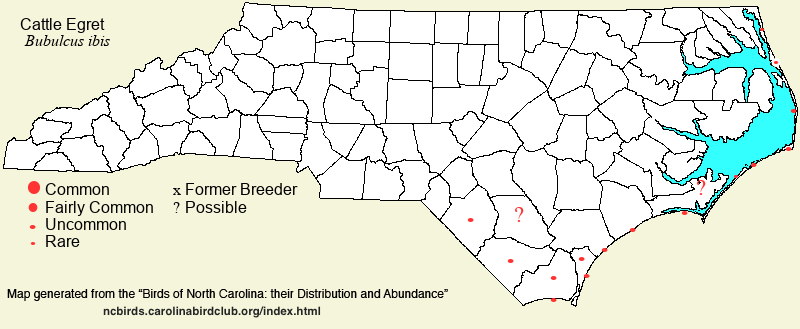 |  |
|
Western Cattle-Egret - Ardea ibis ARDEIDAE Members: | Search Common: Search Scientific: |
|
|
||||||
| General Comments |
This formerly Old World species has a most unusual history in the New World. "Cattle Egrets" apparently arrived in South America (likely from Africa) around 1930, perhaps by riding on a ship(s). At any rate, the species greatly expanded in numbers in the Western Hemisphere, filling a vacant niche (feeding around cattle and other livestock), and moved northward. It was first found in North Carolina in Bladen in Apr 1956 and was noted nesting at Battery Island (Brunswick) in Jun of that year. By the 1970's, when systematic colonial waterbird surveys began along the coast, the species was a fairly common to locally common breeder. Numbers, however, have declined since the 1990's, probably owing to the loss of farmland -- especially cattle pastures -- in the proximity of breeding colonies. Even so, the species currently nests on scattered coastal islands and at a few inland colonies in the lower Coastal Plain. It is sporadically seen farther inland, both in spring and late summer. As indicated above, the species favors feeding on insects that are kicked up around the feet of livestock, such as at cattle pastures and feed lots, but they also feed in recently plowed fields and in short-grass areas, such as large lawns. Occasionally, they are seen at pond margins and other wetlands, but nearly all white-plumaged waders in such wet areas are Great or Snowy egrets or immature Little Blue Herons.
NOTE: The AOS (formerly AOU) split the former Cattle Egret into two species in 2024; the one in North America is the Western Cattle-Egret. | |||||
| Breeding Status | Breeder | |||||
| NC BRC List | Definitive | |||||
| State Status | ||||||
| U.S. Status | ||||||
| State Rank | S4B | |||||
| Global Rank | G5 | |||||
| Coastal Plain | Summer resident and transient, and straggler in winter, but generally absent by late winter. Fairly common but somewhat local breeder along the coast; formerly more common. Nests on coastal islands, but tends to forage on the nearby mainland, thus can be difficult to see on barrier islands; very rare in winter. Tidewater: non-breeding visitor in the warmer months, generally uncommon; rare and local in early winter. A few linger into early winter in fields near Lake Mattamuskeet. Farther inland: nests in good numbers at Lay's Lake (Columbus), Warwick Mill Bay (Robeson), and Dunahoe Bay (Robeson), and perhaps at a few other sites; generally rare to very uncommon away from nesting colonies (except in nearby pastures), during migration and in summer. An apparently new breeding site was found in 2024 at a Bladen pond, where about 200 nests and 600 birds were found on 13 Jul. Occurs mainly from mid-Mar to early Nov; rare in early winter, and very rare by mid-winter. Peak counts: 1,000, Open Ground Farm (Carteret), 11 Sep 2005; 900, in flight over North River Preserve (Carteret), 25 Aug 2019; 600 (see above); 500, near Maxton (Robeson), 18 Sep 2008. A tally of 58 at Fairfield (Hyde) on 1 Jan 2016 is perhaps a winter-season high count. | |||||
| Piedmont | Transient and post-breeding visitor; records declining in recent years. Rare in the eastern counties, and very rare to rare over most of the province; late Mar to early Jun, and Jul to early Oct, very rare into Nov; casual in winter (3 records in Dec and Jan). Peak counts: 20, Durham, Apr-May 1962; 18, Old Fort, 18 Oct 1980; 15, Raleigh, May 1967. | |||||
| Mountains | Transient, at low (to rarely middle) elevations. Very rare, mainly early Apr to early Jul; casual to very rare from late Sep to early Dec, even though the highest counts have been at this season. One photographed in southern Ashe on 17 Jul 2021 might have been a first record for the northern mountains, followed a few months later by one at Bakersville (Mitchell) on 31 Oct 2021, equally notable and rather late. Peak counts: 15, in flight over Lake Julian (Buncombe), 23 Sep 2022; 12, Biltmore Estate (Buncombe), 23 Oct 2020; 11, Hendersonville, 24 Sep 1974. | |||||
| Finding Tips |
Unlike other waders, the Western Cattle-Egret is seen mostly in pastures, but it may be seen in lawns, plowed fields, and other open areas generally away from tidal water. It may be difficult to find before Apr and after Sep or Oct. The best places to see them are likely in cattle pastures within a few miles of Dunahoe Bay and Warwick Mill Bay in Robeson. ** to *** | |||||
| Attribution | LeGrand[2025-02-03], LeGrand[2024-11-04], LeGrand[2024-07-19] | |||||
| NC Map Map depicts all counties with a report (transient or resident) for the species. | Click on county for list of all known species. |
| NC Breeding Season Map Map depicts assumed breeding season abundance for the species. |  |